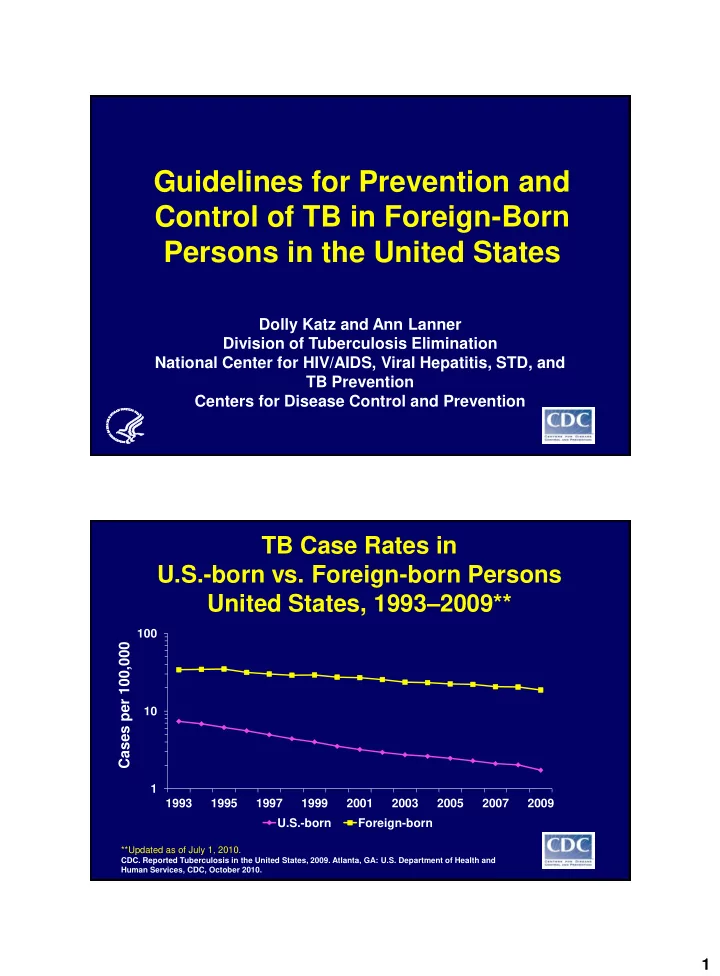

Guidelines for Prevention and Control of TB in Foreign-Born Persons in the United States Dolly Katz and Ann Lanner Division of Tuberculosis Elimination National Center for HIV/AIDS, Viral Hepatitis, STD, and TB Prevention Centers for Disease Control and Prevention TB Case Rates in U.S.-born vs. Foreign-born Persons United States, 1993 – 2009** 100 Cases per 100,000 10 1 1993 1995 1997 1999 2001 2003 2005 2007 2009 U.S.-born Foreign-born **Updated as of July 1, 2010. CDC. Reported Tuberculosis in the United States, 2009. Atlanta, GA: U.S. Department of Health and Human Services, CDC, October 2010. 1
Focus on Latent TB Infection (LTBI) in Foreign-Born Persons in the United States • 6.9 million persons infected – Almost 1 in 5 • 4% start and complete treatment • Increasing that to 8% would reduce TB cases by almost half over 40 years 2
TB Rates/100,000 by Origin,Time in U.S. ≥2 years in U.S. Region of origin <2 years in U.S. Sub-Saharan Africa 389.2 51.9 East Asia/Pacific 170.7 31.3 South America 64.4 15.3 Central America 201.0 20.2 Mexico 69.4 14.6 Western Europe 7.1 1.9 Canada 1.4 0.9 United States 2.5 Source: CDC, unpublished data Key Considerations • Risk of TB disease is high among nearly all foreign-born persons • TB screening and treatment are increasingly moving from the health department to the wider community • Individual physicians need simplicity • Health departments and other institutions have limited resources for screening 3
Development of Guidelines 40-member advisory group Approve draft outline Approve general concepts Form working groups to write specific sections 10-member consensus panel Who to screen? How to screen? Who to treat? Major Recommendations 1. Screening for risk Medical providers, health departments, and institutions such as colleges and universities should screen all persons at intake/admission for TB risk related to country of birth. 4
Major Recommendations 2. Screening for disease/infection Every person born in a country with TB rates higher than those in the United States should be screened for TB disease, which includes testing for latent TB infection (LTBI), at least once as part of routine health maintenance. Countries/regions with TB rates equal to or lower than U.S. rates Australia Barbados Canada Grenada Israel Jamaica New Zealand United Arab Emirates Most countries of Western Europe 5
Countries of the world with TB rates equal to or lower than U.S. rates Major Recommendations 3. LTBI treatment May be prescribed for anyone without a contraindication, but highest priority should go to persons with Residence in United States ≤2 years Age ≤35 years Standard risk factors for progression 6
Major Recommendations 4. IGRA vs TST Preference for interferon gamma release assays (IGRAs) over tuberculin skin tests (TST) for most foreign-born persons because of higher specificity in BCG vaccinated Exception: children <5 years old Major Recommendations 5. Evaluation of persons with B notifications Specific guidance to health departments for follow-up and evaluation of immigrants entering the U.S. with B notifications Under both new (2007) and old technical instructions 7
Major Recommendations 6. Guidelines for other institutions Expansion of guidelines to include recommendations for institutions and businesses that interact with foreign-born persons Major Recommendations 7. Policy recommendations, federal government Simplify oversight of civil surgeons and panel physicians Require TB evaluations for long-term nonimmigrants Add TB screening to Healthcare Effectiveness Data and Information Set (HEDIS) Fund global TB control strategies 8
Major Recommendations 8. Policy recommendation, states Promulgate regulations for TB risk screening and follow-up testing and treatment in colleges and universities Consensus Panel Members • John Bernardo, M.D., Boston • Kevin Cain, M.D., CDC • Michael Fleenor, M.D., Alabama • Dolly Katz, Ph.D., CDC • Masae Kawamura, M.D., San Francisco • Phil LoBue, M.D., CDC • Kathleen Moser, M.D., San Diego • Tom Navin, M.D., CDC • Randall Reves, M.D., Denver • Deborah Sodt, R.N., Minnesota 18 9
Advisory Group for Development of Guidelines HRSA/Immigration Health State/city TB controllers Services Deb Sodt, RN, Minnesota Diana Schneider, DrPH Gloria Pena, RN, Laredo USCIS Sonal Munsiff, MD, NYC Lynn Feldman Jim Cobb, Florida Pearl Chang James Watt, California USAID ACET Amy Bloom, MD Masae Kawamura, MD DHHS/Minority Health Off Mike Fleenor, MD Claude Colimon NTCA Assoc of Asian Pacific John Bernardo, MD CHOs Jeff Caballero, MPH Expert clinicians/academics CURETB Randall Reves, MD,Denver Kathy Moser, MD Dick Menzies, MD,Montreal Project Concern International Patient advocate Paris Cerecer, MD Peijun Zheng Migrant Clinicians Network Ed Zuroweste, MD Public Health Agency of Canada Ed Ellis, MD, TB Control 10
CDC/ Division of TB CDC/Division of Global Migration Elimination and Quarantine Lauren Lambert, MPH Mary Naughton, MD Nick DeLuca, PhD Drew Posey, MD Beverly Metchock, DrPH CDC/Office of Global Health Paul Tribble, MA Eugene McCray, MD Mark Lobato, MD CDC/Global AIDS Program Mary Reichler, MD Anand Date, MD Robin Shrestha-Kuwahara, CDC/Division of HIV/AIDS MPH Eyasu Teshale, MD Suzanne Marks, MPH, MA Kevin Cain, MD Tom Navin, MD Phil LoBue, MD Bill Mac Kenzie, MD Maureen Wilce, MA 11
Recommend
More recommend